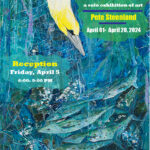Design Students See Hidden Potential in Melbourne’s Historic Ice Plant
A little imagination can go a long way when it comes to breathing new life into an old building — at least that’s what local historian Lesa Larusso believes.
To prove her point, Lesa, who heads up Eastern Florida State College’s (EFSC) Interior Design program, recently put a group of design students to the task of re-imagining one of Brevard County’s most notable historic buildings: The Melbourne Ice Plant which was built in 1926.
“There is a wide spectrum of philosophies when it comes to historic preservation. Once a group or community has made the heroic decision to preserve a resource, the question that often arises is how, exactly, should the building be preserved,” Lesa explained.
From that premise — Lesa designed a college course called “Why Preservation?” The class was previously taught at both EFSC and at Florida Tech. Each session has always emerged as a hands-on team project matching small groups of students with one of the Space Coast’s historic buildings.
Student Chelsea Patrick said she appreciated learning the history of the ice plant as much as she enjoyed considering how it could be revamped and better utilized today.
“We liked working with this space because of its commercial history and its community value,” said Chelsea. “We got to know it like a friend. If you don’t know the history of a place, you can’t go anywhere with it. You can’t go anywhere if you don’t know where you’ve already been.”
The Old Melbourne Ice House
Nestled back along the west side of US1, just a block north of Melbourne’s revived downtown shopping district, the historic ice plant was formerly owned by the Florida Power and Light Company (FPL).
Construction on the plant began in December 1926. The original estimated cost was $30,000 but the final construction cost has been listed at $100,000 by the National Registry of Historic Places. The plant, which had an ice capacity of 50 tons at its peak, ceased operation in 1977.
Soon after the plant stopped making ice, it was scheduled for demolition. The once-condemned 16,000-square-foot masonry building was spared after being declared a historical landmark by the Florida Historical Society in 1982.
The two-story ice plant was purchased from FPL by Melbourne oncologist Dr. Craig Deligdish, who remodeled the outside of the structure in the mid-1990s. At that time, the building space was enlarged to 24,000 square-feet after the addition of a 6,000 square-foot third floor.
By 2000, more than $2 million in repairs went into the building. At that time, Steve Totty, president of Totty Construction said the building was redesigned into the style of a New York-style loft.
Students Share Their Ideas
Dr. Diehl-Saffer, who taught the preservation course over the summer, and her students recently presented their ideas to Melbourne’s Historic Preservation Board. Amna Murshed showed the first floor of the building being converted into a café with dining and seating areas, a tasting bar, a product display area and a book corner with comfortable seating.
Bradley Hoe and Jennifer Scites said their inspiration was the Art Deco period which became the theme for their colors, signage and furnishings. Their idea was to turn the plant into a Jazz Club — a concept that closely mirrored a recently completed project in St. Augustine where an old ice plant was transformed into a bar and distillery.
Chelsea Patrick and Brittany Loper saw the first floor being converted into residential and storage space, and the third floor being demolished. In their presentation, the second floor housed an ice skating rink, a customer service desk and an eatery. The roof space would be turned into a rooftop bar with gardens. Their design also incorporated solar panels.
In total, eight students worked on the project including the student presenters and Veronica Taroucci, Justin Champion and Tiffany Ruehman.

Dr. Diehl-Saffer, who taught the preservation course over the summer, and her students recently presented their ideas to Melbourne’s Historic Preservation Board.
The historic Melbourne Ice Plant is a massive 24,000-square-foot three-story cement structure which once cranked out hundreds of pounds of ice for fishermen, businesses and residential customers throughout the Space Coast. Long before refrigerators and ice makers existed, citizens relied on super-sized ice plants to produce the frozen cubes needed to preserve cold food. That era is gone forever and now ice plants across America tend to be abandoned, under-utilized or at risk of being demolished.
This article appears in the December 2014 issue of SpaceCoast Living.
Did you like what you read here? Subscribe to SpaceCoast Living













